Last updated on
Discover the foolproof method to maneuver your couch through a narrow doorway without breaking a sweat in this comprehensive guide.
Have you ever found yourself in a frustrating situation where you just can’t seem to fit your beloved couch through the door? Maybe you’re moving into a new home or simply rearranging your current space, but either way, getting that bulky piece of furniture through a narrow doorway can feel like an impossible feat. But don’t worry, because with the right tools and techniques, fitting a couch through a door is easier than you might think.
In this article, we’ll guide you through the steps to successfully maneuver your couch into any room without damaging it or your walls. So grab some gloves and let’s get started!
Key takeaways:
- Measure your couch accurately to determine if it can fit through the door.
- Measure the dimensions of the doorway to compare with your couch measurements.
- Consider removable parts and flexibility when correlating couch and opening sizes.
- Take note of the shape and dimensions of your couch to assess potential challenges.
- Protect your couch with blankets or plastic wrap and cover doorways and walls to prevent damage.
Table of Contents
Measure Your Couch

The first step in fitting your couch through a narrow doorway is to measure the dimensions of your furniture. This will help you determine if it can fit through the opening and which techniques to use for maneuvering it.
Start by measuring the height, width, and depth of your couch from its widest points, including any protruding parts like armrests or legs.
Once you have these measurements, write them down on a piece of paper or save them on your phone so that you can easily refer back to them later. It’s important to be as accurate as possible when measuring because even an inch difference could make all the difference in whether or not your couch will fit through the door.
Keep in mind that some types of sofas may be more difficult than others when it comes to fitting through tight spaces. For example, sectional sofas with multiple pieces may require disassembly before they can pass through a narrow doorway.
Measure Doorway Dimensions
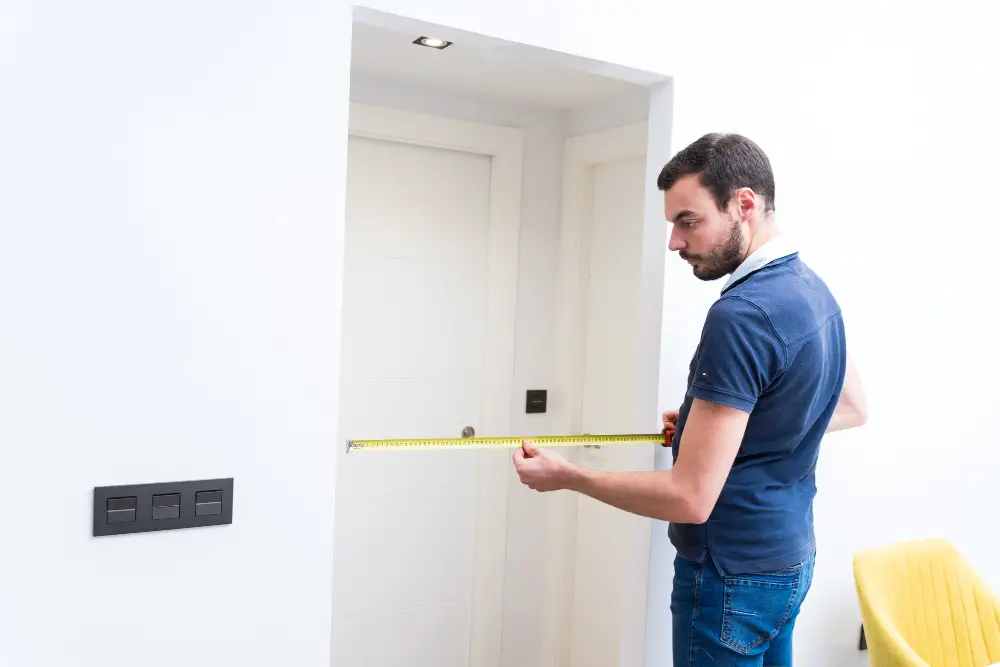
This will help you determine if your couch can fit through without any modifications or if you need to take additional steps. To get accurate measurements, use a tape measure and record both the height and width of the doorway at its narrowest point.
Once you have these measurements, compare them with those of your couch. If there’s not enough clearance for your sofa to pass through comfortably, don’t worry! There are several techniques that we’ll cover later on in this article that can help make it happen.
It’s important to note that doorways aren’t always perfectly square or level, so be sure to take multiple measurements from different angles for accuracy. Consider any obstacles such as light fixtures or molding around the door frame when measuring.
Correlate Couch and Opening Sizes

This step is crucial in determining whether or not your couch will fit through the opening. If your couch is too large for the doorway, don’t panic just yet! There are a few things you can do to make it work.
Firstly, consider if there are any parts of the couch that can be removed temporarily such as legs or armrests. Secondly, think about how flexible and malleable your sofa is – some sofas have more give than others which could help when maneuvering them through tight spaces.
Consider Couch Shape

Sofas with low backs and narrow arms are generally easier to maneuver than those with high backs or wide armrests. Sectional sofas may also pose more of a challenge due to their size and shape.
Before attempting to move your couch, take note of its dimensions and any unique features that could impact its ability to fit through doorways or hallways. If you’re unsure whether your sofa will fit, consider taking measurements from multiple angles or consulting with an expert.
Remember that even if you have successfully moved this same couch before in another location doesn’t mean it will be easy this time around as every space is different in terms of layout and design.
Remove Cushions and Other Parts
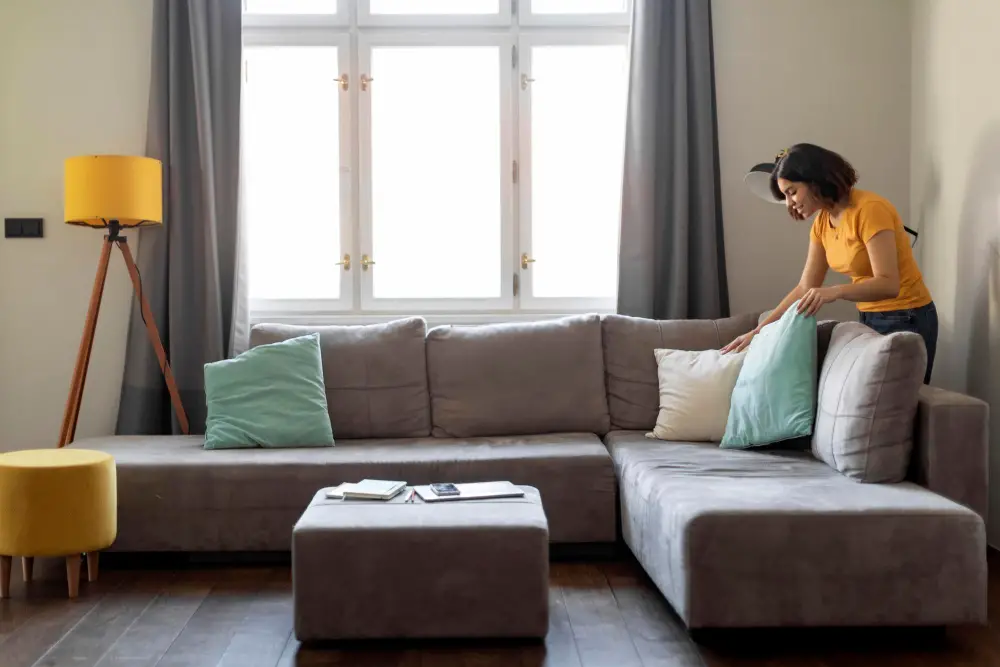
This includes cushions, legs, and other removable components. Removing these parts will not only make the couch lighter and easier to maneuver but also reduce its overall size.
Start by removing all of the cushions from your couch. If possible, store them in a safe place where they won’t get damaged or dirty during transport.
Next, check if there are any legs or feet attached to your furniture piece that can be unscrewed easily with a screwdriver.
If you’re unsure how to remove certain parts of your sofa safely without causing damage or voiding warranties (if applicable), consult manufacturer instructions before proceeding further.
Disassemble the Couch

Before you start taking apart your couch, make sure you have a clear understanding of how it was put together in the first place. Check for any screws or bolts that hold different parts of the frame together and use a screwdriver or wrench to remove them carefully.
Once all screws and bolts are removed, gently pull apart each section of the frame until they come loose from one another. Be careful not to damage any upholstery while doing so.
It’s important to keep track of all pieces as you take them off so that reassembly will be easier later on. You can also label each piece with masking tape if needed.
Remove Door and Hardware
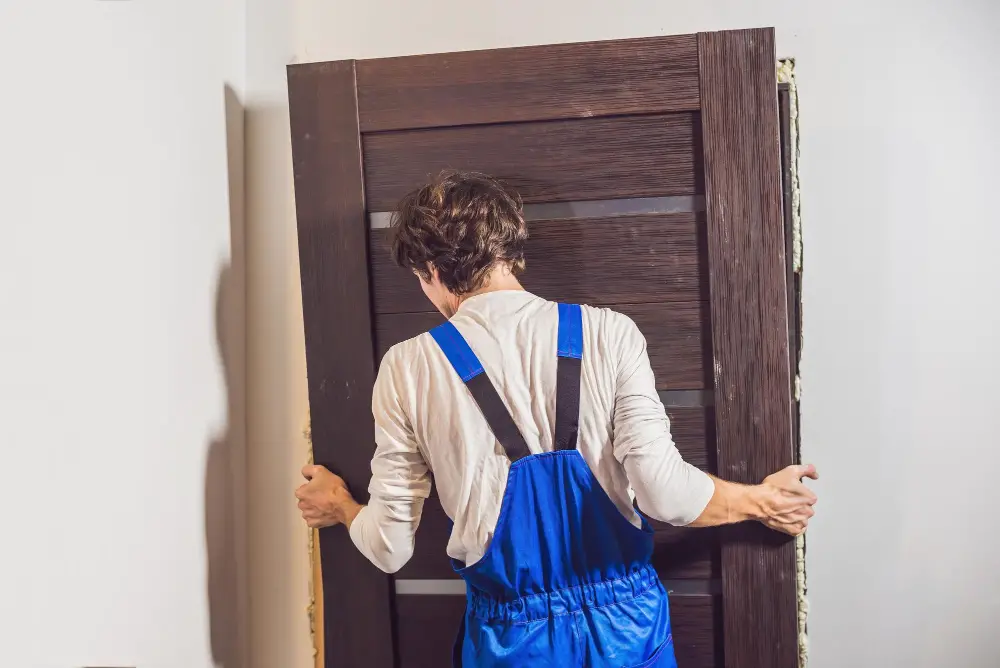
This will give you more space to work with and prevent any damage to the door or walls during the moving process.
To remove a standard interior door, start by unscrewing all of the hinges from both sides of the doorway. If there are any screws that won’t budge, try using a drill or screwdriver with more torque.
Once all of these screws have been removed, gently lift up on one side of the door while pulling it towards you until it comes off its hinges.
If your doorway has an exterior or heavy-duty metal frame that can’t be easily removed in this way, consider using a crowbar or pry bar instead. Insert one end behind each hinge plate on either side of where they attach onto their respective jamb pieces before applying pressure downwards until they pop outwards enough for removal without damaging anything else around them.
Remove Door Stops and Hinges (Optional)
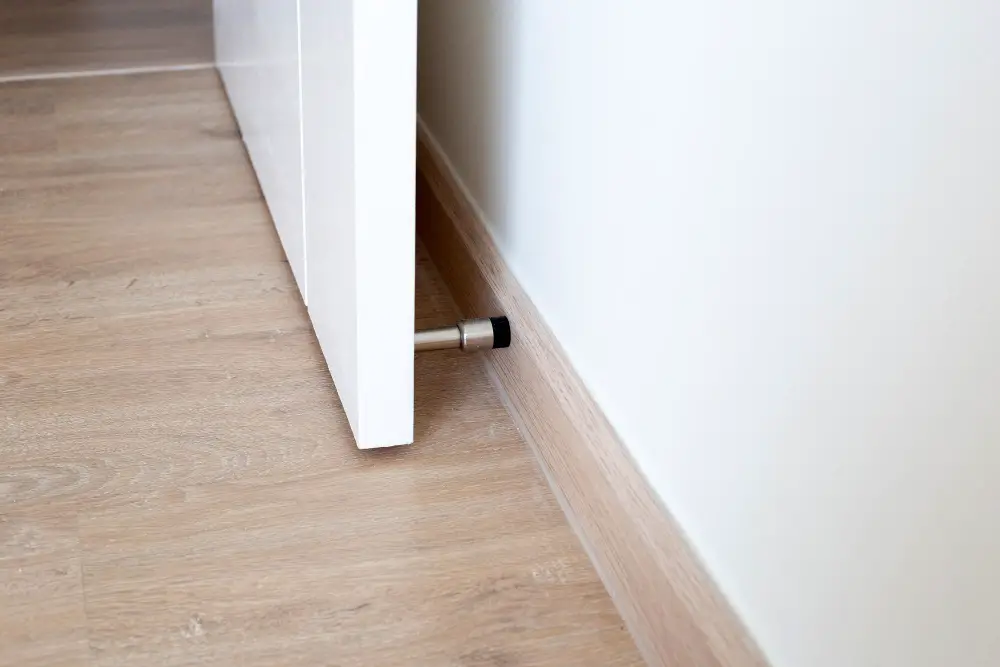
Door stops are small pieces of wood or metal that prevent doors from swinging too far open and damaging walls. Hinges, on the other hand, are what allow doors to swing open and closed.
Removing these components is an optional step but can make all the difference in getting your couch through a narrow opening. Use a screwdriver or power drill to remove any screws holding them in place carefully.
However, before you start unscrewing anything from your door frame, it’s essential to consider whether this is necessary for fitting your couch into space safely. Removing these parts may cause damage if not done correctly or could void any warranties on new homes/appliances.
Protect Your Couch

Covering your couch with a protective layer will prevent scratches, tears or stains that could occur while navigating through tight spaces. You can use old blankets, towels or even plastic wrap to cover the entire surface of the couch.
Secure them in place with tape or bungee cords so they don’t slip off during transport.
If you’re moving on a rainy day, make sure to cover your furniture with waterproof materials such as tarps or plastic sheets before leaving home. This will keep moisture away from delicate fabrics and prevent water damage.
Remember that protecting your couch is not only important for its appearance but also for its longevity.
Protect Doorway and Walls

This step is crucial in preventing damage to both your furniture and home.
To protect the doorway from scratches or dents caused by moving the couch through it, use a protective covering such as cardboard or blankets. Secure them with tape so they don’t slip off during movement.
For added protection of walls near the doorway, cover them with drop cloths or plastic sheeting secured with painter’s tape. This will prevent accidental scrapes or marks on painted surfaces.
Prepare the Room
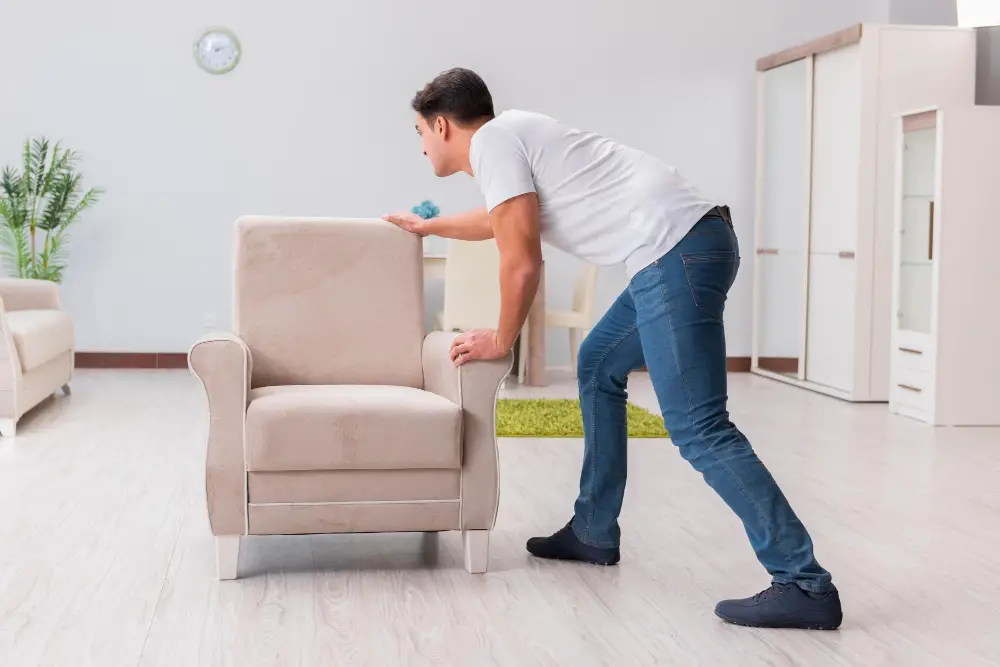
Clear any obstacles that may be in the way and remove any fragile items from the area. This will give you enough space to maneuver your couch without causing damage or injury.
If there are any tight corners or narrow hallways leading up to the room, consider removing doors or hinges beforehand for easier access. You can also lay down protective coverings on floors and carpets to prevent scratches and stains.
It’s also a good idea to have a plan of action before starting so that everyone involved knows what needs to be done. Assign roles if necessary, such as one person guiding while another pushes from behind.
Angle and Pivot Techniques

This technique involves tilting the couch at an angle, so it can fit through the door frame. Here’s how you can do it:
First, position your couch in front of the doorway with one end facing towards it. Then, tilt one end of your sofa upwards while keeping its other side on the ground.
Next, rotate or pivot that tilted side into space where there is more room available (usually inside). You may need someone else to hold onto this part as you move around.
Once that first section has cleared enough space inside or outside (depending on which way you’re moving), lower it down and repeat with another section until all parts are safely moved across without any damage done!
Move the Couch Horizontally or Vertically

To move it horizontally, angle the couch so that one end faces the door and then slide it across the floor. This technique works best if you have a smooth surface like hardwood or tile.
To move your couch vertically, stand it on its end with one person holding each side and carefully maneuvering through the doorway. Make sure to protect both your walls and furniture by using blankets or padding during this process.
Remember that moving a heavy piece of furniture can be dangerous without proper precautions in place. Always wear gloves for grip and lift with your legs instead of bending over at the waist which could cause injury.
Move the Couch Diagonally (Optional)

This technique involves tilting the couch at a 45-degree angle and maneuvering it through the door in a diagonal motion. However, this method can be risky as it increases the likelihood of damaging both your furniture and walls.
Before attempting to move your couch diagonally, make sure that there is enough clearance on either side of the door frame for you to pivot without causing any damage. You should also ensure that there are no obstacles or sharp corners along your chosen path.
To move your couch diagonally, have one person hold onto each end of the sofa while tilting it at a 45-degree angle towards one corner of its base. Slowly guide and pivot around any obstacles until you reach an area where you can straighten out again.
Remember that this technique requires careful coordination between all parties involved in order to avoid accidents or injuries. If possible, enlist additional help from friends or family members who can assist with lifting and guiding during this process.
Move the Couch in a Semi-Circle Motion

This technique involves angling the couch at a 45-degree angle and then pivoting it around its corner legs while keeping one end of the couch stationary. By doing this, you can create more space for your furniture to pass through without damaging any walls or door frames.
To execute this method successfully, make sure that there is enough room on either side of the doorway for you to maneuver comfortably. You may also need someone else’s help with lifting and rotating the couch as needed.
Remember always to protect both your furniture and home during this process by using blankets or towels as padding where necessary.
Move the Couch On Its Back

This method works best for sofas with removable legs or those that are not too heavy to lift. To move your couch on its back, start by removing any cushions and flipping the sofa over so that it rests on its back.
Next, enlist some help to lift one end of the couch while someone else guides it through the doorway. Be sure to protect both your furniture and floors by using blankets or towels as padding underneath.
Once you’ve successfully moved your couch into position, carefully flip it upright again and reattach any removed parts such as legs or cushions.
Remember: moving a large piece of furniture like a sofa can be challenging even with these techniques in mind.
Assess Alternative Routes

Consider if there are any other access points that could work better for moving your furniture. Perhaps a window or balcony could be used as an entry point instead of the doorway.
If you live in an apartment building, check with management to see if there is a service elevator or another entrance that would allow easier access.
Another option is to take apart more of your couch than initially planned and reassemble it once inside the room. This may require some additional tools and expertise but can be worth considering if all else fails.
Remember, safety should always come first when attempting these maneuvers on your own. Don’t hesitate to enlist help from friends or family members who have experience in moving large items safely without causing damage.
Check Out Other Access Points

Take a walk around your home and see if there are any windows or sliding doors that could provide an alternative entry point for your furniture. If you live in an apartment building, check with management to see if there is a freight elevator or service entrance that could be used for large items like couches.
In some cases, it may even be worth considering removing part of the wall temporarily to create a larger opening. Of course, this option should only be considered as a last resort and should always involve professional help.
Remember: when all else fails, don’t force it! Trying too hard can result in damage not only to your couch but also potentially harm yourself or others involved in the process.
Enlist Help or Hire Professionals

Moving a large piece of furniture like a couch can be physically demanding and potentially dangerous if not done correctly. If you have friends or family members who are willing to lend a hand, make sure they understand the plan before starting.
Assign specific roles and communicate clearly throughout the process.
Alternatively, consider hiring professional movers who specialize in moving bulky items like sofas. They will have experience with navigating tight spaces and know how to protect both your furniture and home during transport.
While enlisting help or hiring professionals may come at an additional cost, it could save you from potential injury or damage caused by attempting this task alone without proper equipment or expertise.
Consider In-Home Assembly
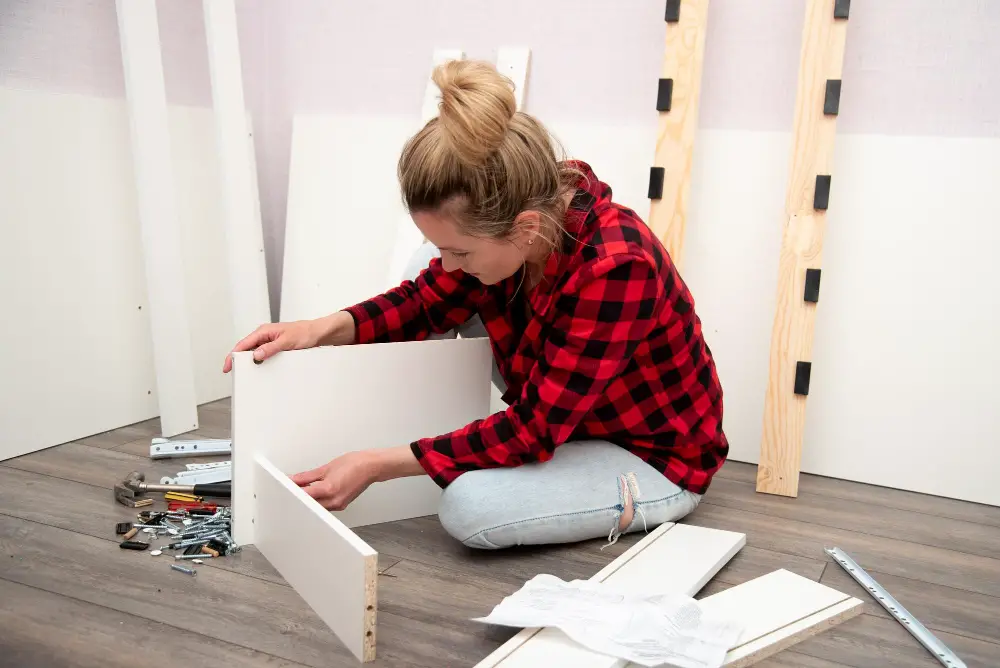
This option is especially useful if you have a sectional or modular sofa that can be assembled piece by piece inside your home. In-home assembly services are available from many furniture stores and professional movers, so do some research before making a decision.
While this option may come with an additional cost, it could save you time and frustration in the long run. Plus, professionals will ensure that your couch is assembled correctly without any damage or scratches.
Fitting a couch through a narrow doorway requires patience and careful planning. By following these steps outlined above or considering in-home assembly as an alternative solution when necessary – moving furniture into tight spaces doesn’t have to be stressful anymore!
FAQ
What do you do if your couch doesn’t fit through the door?
If your couch doesn’t fit through the door, place it vertically on its end and twist it slowly into the doorway, or try squeezing it through as sofas are often soft enough to fit through narrower spaces.
How do you fit a sofa through a door?
To fit a sofa through a door, remove the door by tapping out the hinge pins and shifting the door sideways, and if necessary, remove the hinges for an additional ½ inch of width.
How do you figure out if a couch will fit through a doorway?
To determine if a couch will fit through a doorway, compare the doorway width to the sofa’s height, ensuring there is additional space on each side, and if the door width exceeds the sofa’s height, it will fit through.
Will a couch fit through a 30 inch door?
A sofa with a maximum depth of 38 inches and a height of 34 inches will fit through a 30-inch door, provided it is a straight shot through the doorway.
What techniques can you use to maneuver a couch around tight corners and narrow doorways?
To maneuver a couch around tight corners and narrow doorways, use techniques such as pivoting, tilting, removing cushions, and disassembling the couch if possible.
Are there specific couch designs available that facilitate easier movement through doors?
Yes, couch designs with detachable or foldable components facilitate easier movement through doors.
What measurements and calculations should be done beforehand to ensure a smooth couch-moving process?
To ensure a smooth couch-moving process, measure the couch dimensions, doorways, staircases, and hallways, and determine the best path and method for moving the couch.





